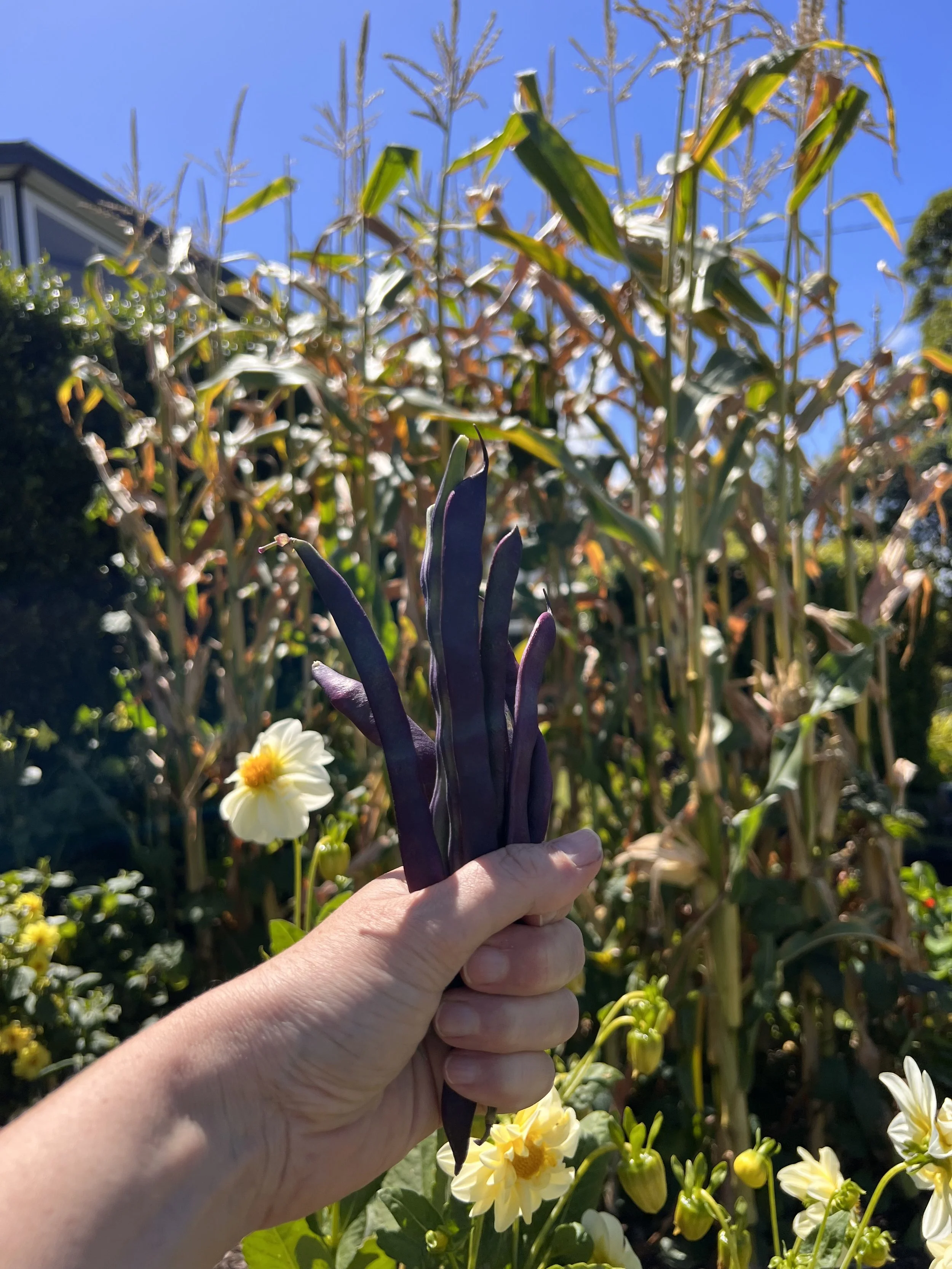THE BENEFITS OF COMPANION PLANTING IN YOUR GARDEN
Corn are finished but are being used as a sturdy trellis for the Purple King beans.
Companion planting is the practice of growing different plants together to benefit one or both of them. It can be used to attract beneficial insects, repel pests, improve soil nutrition and water retention, optimize air circulation, and more. Companion planting has been practiced for centuries in many cultures around the world as a way of creating an optimal environment for growing plants. By understanding the relationships between different plant species, gardeners can create a thriving ecosystem in their gardens and enjoy healthy and abundant harvests. There is no one-size-fits-all approach to companion planting; each gardener must consider the specific characteristics of their plants and environmental conditions when determining what will grow best together. However, some general companion planting principles can be followed to ensure a successful garden. Following companion planting can result in higher yields and better tasting produce.
Definition & History
One of the most important benefits of companion planting is the impact it can have on pest control. By growing certain plants together, gardeners can create an environment that repels pests and attracts beneficial insects such as ladybugs and lacewings that feed on aphids and other harmful insects. Additionally, companion planting can help to improve soil nutrition by promoting the exchange of beneficial nutrients between plants. Growing nitrogen-fixing legumes alongside vegetables and other plants that need more nitrogen in the soil can be very beneficial as it increases the available nitrogen for other plants.
Plants can also be used to optimize air circulation, reduce moisture levels and reduce the spread of disease. For example, planting tall plants such as corn or sunflowers can be used to shade and protect other plants from direct sunlight and wind. By creating a microclimate with companion planting, gardeners can improve their overall yields and produce healthier crops.
Companion planting is not only beneficial for the plants themselves but also for the gardeners who can enjoy a more efficient and abundant harvest. By understanding the relationships between different plants and creating an optimal environment for growth, gardeners can make their gardens flourish and benefit from healthy harvests for years to come.
Choosing Compatible Plants
When selecting plants for your garden, it is important to consider the compatibility of each type. Incompatible plants may struggle to grow and thrive, or worse, they could become a weed problem that takes over the entire plot. Additionally, some plants require more water and attention than others, so it's important to choose compatible plants with similar needs.
Before selecting plants, take some time to research the varieties that grow best in your area. For example, if you live in a dry climate, look for drought-tolerant plants that can thrive with minimal water. Conversely, if your region is damp and humid, opt for moisture-loving species that will flourish in wet conditions.
Similarly, choose plants that prefer the same level of sunlight. Many plants require direct sunlight for several hours a day, while others can tolerate more partial shade. Compare your options and select ones that will grow well together in terms of required sun exposure.
It's also important to consider whether compatible plants have similar nutrient needs. Some plants may need more nitrogen or phosphorus than others, so be sure to mix and match varieties that will have enough of each nutrient to grow properly.
When choosing compatible plants for your garden, think about all these factors to ensure success. With some careful research and planning, you can create a beautiful space with a variety of compatible plants that will bring life to your garden.
Popular Companionships in the Garden
One of the most popular companionships in the garden is between plants and flowers. Planting a variety of colourful annuals, perennials, ornamental grasses, and ground-covers like sweet woodruff or thyme can provide a beautiful burst of colours and textures that will attract beneficial pollinators like butterflies. Tall plants such as sunflowers, cannas and coneflowers can be used as a backdrop for shorter plants like daisies or lavender.
Plants can also be paired with herbs to create attractive combinations. Growing basil beneath tall tomato plants will not only provide a beautiful contrast of colours, but the basil's strong scent will also repel pests from the tomatoes. Basil can also be combined with parsley, oregano, sage or chives to create a fragrant and visually pleasing herb garden.
Another popular companionship in the garden is between shrubs and trees. Planting evergreen shrubs beneath tall trees will create a shady oasis where ferns, mosses and other shade-loving plants can thrive. Dwarf shrubs, such as boxwood or holly, can be used to create low hedges or borders around flowerbeds and walkways.
Finally, one of the most popular companionships in the garden is between vegetables and flowers. Planting tall sunflowers next to fast-growing vegetables like beans and cucumbers will provide a natural trellis for the vegetables to climb, while also providing colour and interest to the garden. Planting marigolds or nasturtiums near vegetable plants can also provide an attractive backdrop as well as helping to repel pests from the vegetables.
In conclusion, choosing compatible plants and popular companionships in the garden is essential for creating an attractive and successful garden. Planning out which plants will thrive together and how they will interact with each other must be taken into consideration when selecting what to plant in your garden. It’s important to understand the needs of each plant before deciding on a companionship. Consider the climate and soil conditions of your area, as well as its local pests before making a decision on which plants to pair together. With proper planning and research, you can create an ideal garden for your own home. A beautiful and successful garden is within reach with the right combination of compatible plants and popular plant companionships.

